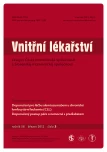The benefits of centralization of care for patients with acute upper gastrointestinal bleeding
Authors:
P. Svoboda 1; M. Konečný 2; V. Hrabovský 1; Arnošt Martínek 1; J. Ehrmann 2; V. Procházka 2
Authors‘ workplace:
Interní klinika Lékařské fakulty Ostravské Univerzity a FN Ostrava, přednosta doc. MUDr. Arnošt Martínek, CSc.
1; II. interní klinika Lékařské fakulty UP a FN Olomouc, přednosta doc. MUDr. Vlastimil Procházka, Ph. D.
2
Published in:
Vnitř Lék 2012; 58(3): 191-195
Category:
Original Contributions
Overview
Introduction:
Acute upper gastrointestinal bleeding still remains one of the serious conditions that require a rapid diagnostic and therapeutic intervention. Such procedure is highly dependent on good interdisciplinary cooperation, which, when centralized, may positively influence mortality and economic costs.
Objective:
To determine the benefits of centralization of care provided to patients with acute bleeding in the upper gastrointestinal tract.
Patients and methods:
A total of 632 patients with acute bleeding were enrolled in the study at two different health-care establishments of the same type, however with a different organisation of care. We have evaluated the influence of the organisation of care on the length of hospitalization stay, mortality and economic costs.
Results:
Centralized treatment significantly shortens the interval from hospital admission to endoscopic examination and leads to a reduction in mortality, although not statistically significant. On the other hand, it does not affect the length of hospitalization, the distribution of patients between internal and surgical departments, and provides no guarantee of lower economic costs. Many other factors play an important role in that respect. It seems, that the importance of centralization plays the main role especially in the pre-hospital and early hospital period, when it accelerates and simplifies the diagnostic and therapeutic procedure.
Key words:
acute bleeding – upper gastrointestinal tract – organisation of care – economic costs
Sources
1. Husová L, Lata J, Šenkyřík M et al. Akutní krvácení z horní části trávicí trubice – naše zkušenosti. Vnitř Lék 2001; 6: 354–360.
2. Konečný M, Ehrmann J, Procházka L et al. Naše zkušenosti s novou organizací péče o nemocné s akutním krvácením do horní části trávicího traktu. Vnitř Lék 2005; 1: 36–51.
3. Rockall TA, Logan RF, Devlin HB et al. Incidence of and mortality from acute upper gastrointestinal haemorrhage in the United Kingdom. Steering Committee and members of the National Audit of Acute Upper Gastrointestinal Haemorrhage. BMJ 1995; 311: 222–226.
4. Vreeburg EM, Snel P, de Bruijne JW et al. Acute upper gastrointestinal bleeding in the Amsterdam area: incidence, diagnosis, and clinical outcome. Am J Gastroenterol 1997; 92: 236–243.
5. Longstreth GF. Epidemiology of hospitalization for acute upper gastrointestinal haemorrhgae: a population-based study. Am J Gastroenterol 1995; 90: 206–210.
6. Machytka E, Ehrmann J, Svoboda P et al. Incidence krvácení do horní části zažívacího traktu v regionu Ostrava-Poruba v letech 2002––2005. Čes a Slov Gastroent a Hepatol 2007; 61: 124–128.
7. van Leerdam ME. Epidemiology of acute upper gastrointestinal bleeding. Best Pract Res Clin Gastroenterol 2008; 22: 209–224.
8. Dítě P, Novotný I, Kroupa R et al. Akutní nevarikózní krvácení do horní části trávicího traktu. Čes a Slov Gastroent a Hepatol 2007; 61: 6–10.
9. Lata J, Kroupa R, Novotný I. Akutní krvácení z horní části gastrointestinálního traktu. Vnitř Lék 2009; 55 (Suppl 1): S29–S33.
10. Jairath V, Kahan BC, Logan RF et al. Mortality from acute upper gastrointestinal bleeding in the United kingdom: does it display a “weekend effect”? Am J Gastroenterol 2011; 106: 1621–1628.
11. Barkun AN, Bardou M, Kuipers EJ et al. International Consensus Upper Gastrointestinal Bleeding Conference Group. International consensus recommendations on the management of patients with nonvariceal upper gastrointestinal bleeding. Ann Intern Med 2010; 152: 101–113.
12. Bjorkman DJ, Zaman A, Fennerty MB et al. Urgent vs elective endoscopy for acute non-variceal upper-GI bleeding: an effectiveness study. Gastrointest Endosc 2004; 60: 1–8.
13. Lim LG, Ho KY, Chan YH et al. Urgent endoscopy is associated with lower mortality in high--risk but not low-risk nonvariceal upper gastrointestinal bleeding. Endoscopy 2011; 43: 300–306.
14. Choudari CP, Palmer KR. Timing of endoscopy for severe peptic ulcer hemorrhage: Out of hours emergency endoscopy is unnecessary. Gastroenterology 1993; 104: A55 (Abst).
15. Sarin N, Monga N, Adams PC. Time to endoscopy and outcomes in upper gastrointestinal cbleeding. Can J Gastroenterol 2009; 23: 849–498.
16. Baradarian R, Ramdhaney S, Chapalamadugu R et al. Early intensive resuscitation of patients with upper gastrointestinal bleeding decrease mortality. Am J Gastroenterol 2004; 99: 619–622.
17. Sandel MH, Kolkman JJ, Kuipers EJ et al. Nonvariceal upper GI bleeding: Differences in outcome for patients admitted to internal medicine and gastroenterological services. Am J Gastroenterol 2000; 95: 2357–2362.
18. Hearnshaw SA, Logan RF, Lowe D et al. Acute upper gastrointestinal bleeding in the UK: patient characteristics, diagnoses and outcomes in the 2007 UK audit. Gut 2011; 60: 1327–1335.
Labels
Diabetology Endocrinology Internal medicineArticle was published in
Internal Medicine

2012 Issue 3
Most read in this issue
- Castleman’s disease
- The role of PET-CT in decision making on the treatment of localized nodular form of pulmonary AL-amyloidosis
- FTO gene and his role in genetic determination of obesity
- Blood pressure changes in chronically haemodialysed patients
